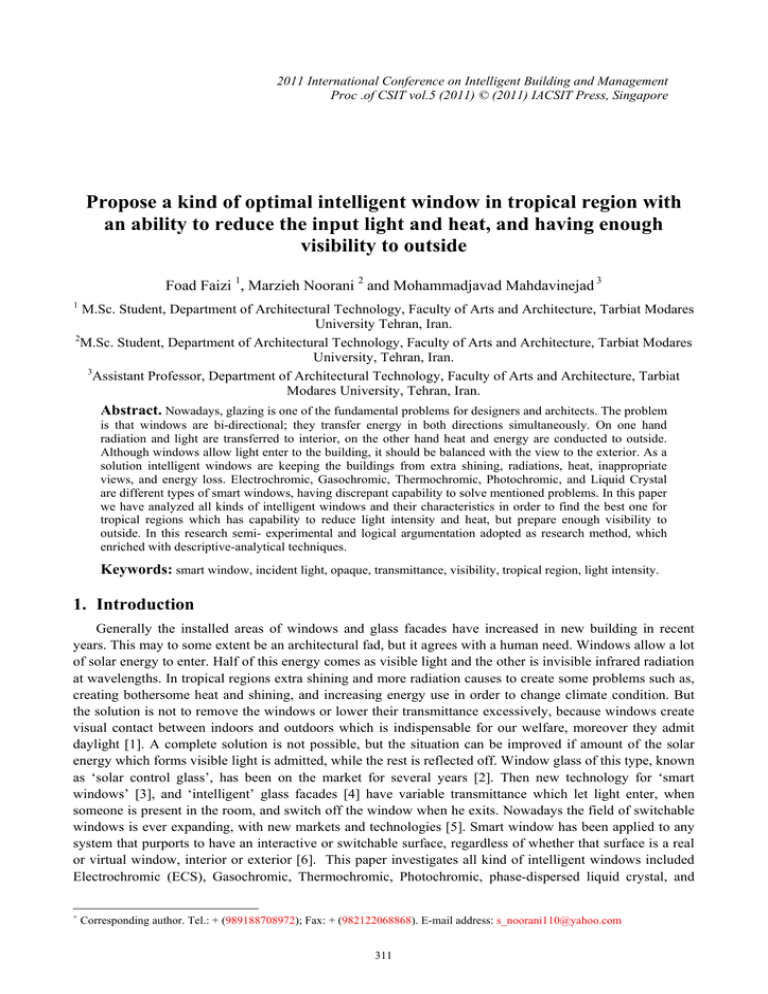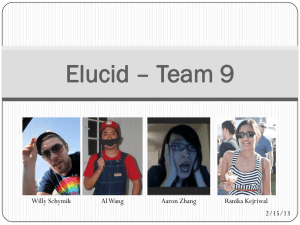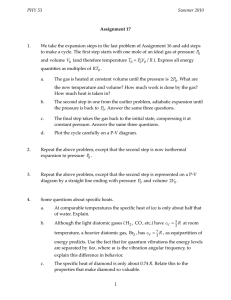Document 13134436
advertisement

2011 International Conference on Intelligent Building and Management Proc .of CSIT vol.5 (2011) © (2011) IACSIT Press, Singapore Propose a kind of optimal intelligent window in tropical region with an ability to reduce the input light and heat, and having enough visibility to outside Foad Faizi 1, Marzieh Noorani 2 and Mohammadjavad Mahdavinejad 3 1 M.Sc. Student, Department of Architectural Technology, Faculty of Arts and Architecture, Tarbiat Modares University Tehran, Iran. 2 M.Sc. Student, Department of Architectural Technology, Faculty of Arts and Architecture, Tarbiat Modares University, Tehran, Iran. 3 Assistant Professor, Department of Architectural Technology, Faculty of Arts and Architecture, Tarbiat Modares University, Tehran, Iran. Abstract. Nowadays, glazing is one of the fundamental problems for designers and architects. The problem is that windows are bi-directional; they transfer energy in both directions simultaneously. On one hand radiation and light are transferred to interior, on the other hand heat and energy are conducted to outside. Although windows allow light enter to the building, it should be balanced with the view to the exterior. As a solution intelligent windows are keeping the buildings from extra shining, radiations, heat, inappropriate views, and energy loss. Electrochromic, Gasochromic, Thermochromic, Photochromic, and Liquid Crystal are different types of smart windows, having discrepant capability to solve mentioned problems. In this paper we have analyzed all kinds of intelligent windows and their characteristics in order to find the best one for tropical regions which has capability to reduce light intensity and heat, but prepare enough visibility to outside. In this research semi- experimental and logical argumentation adopted as research method, which enriched with descriptive-analytical techniques. Keywords: smart window, incident light, opaque, transmittance, visibility, tropical region, light intensity. 1. Introduction Generally the installed areas of windows and glass facades have increased in new building in recent years. This may to some extent be an architectural fad, but it agrees with a human need. Windows allow a lot of solar energy to enter. Half of this energy comes as visible light and the other is invisible infrared radiation at wavelengths. In tropical regions extra shining and more radiation causes to create some problems such as, creating bothersome heat and shining, and increasing energy use in order to change climate condition. But the solution is not to remove the windows or lower their transmittance excessively, because windows create visual contact between indoors and outdoors which is indispensable for our welfare, moreover they admit daylight [1]. A complete solution is not possible, but the situation can be improved if amount of the solar energy which forms visible light is admitted, while the rest is reflected off. Window glass of this type, known as ‘solar control glass’, has been on the market for several years [2]. Then new technology for ‘smart windows’ [3], and ‘intelligent’ glass facades [4] have variable transmittance which let light enter, when someone is present in the room, and switch off the window when he exits. Nowadays the field of switchable windows is ever expanding, with new markets and technologies [5]. Smart window has been applied to any system that purports to have an interactive or switchable surface, regardless of whether that surface is a real or virtual window, interior or exterior [6]. This paper investigates all kind of intelligent windows included Electrochromic (ECS), Gasochromic, Thermochromic, Photochromic, phase-dispersed liquid crystal, and + Corresponding author. Tel.: + (989188708972); Fax: + (982122068868). E-mail address: s_noorani110@yahoo.com 311 suspended particle device (SPDS) in order to find best one for tropical region which has capability to reduce light intensity and heat, but prepare enough visibility to outside. 2. Function of Smart Windows On one hand, transmitting the direct sunlight in winter to diminish the interior heating load, and on the other hand, preventing direct sunlight to reduce the cooling load in summer, are the most important function for smart windows that enable pleasant living and energy conservation [7]. Intelligent windows typically have one or more of the following functions: • Control of the thermal absorption. Transparency and conductivity tend to be mutually related with each other, but are comparatively independent of the incident radiation. Whenever the inside temperature is higher than the outside temperature, a bi directional heat flow is founded: radiant energy transmits in, while heat energy transfers out. • Control of optical transmission. A shift in the transparency of smart windows may be used to alleviate solar radiation, especially in the visual and near ultraviolet wavelength. The window would alter from high density for the prevention of direct sun permeation and it’s attributed radiance to low density as incident light omits intensity. • Control of view. Controlling view is recently the fastest growing application of intelligent windows in buildings. Interior panels and partitions that change from transparent to opaque allow light to transmit, but are able to limit the view. • Control of thermal transmission. The wavelengths extend into the near infrared region of the spectrum. Appropriate heat transmittance can be decreased by radiation (in summer), and increased for other conditions [6]. The functions of smart windows Control of optical transmittance Control of thermal transmittance Control of thermal absorption Control of view Preventing the ultraviolet wavelength Preventing the infrared wavelength Radiant energy transfer in and thermal energy transfer out Switch from transparent to translucent or vice versa Fig. 1: Different Type of Smart Windows 2.1. Thermochromic Windows Thermochromic windows are more responsive to the heat issue; they change transparency in response to temperature. These windows let in all of the sun's energy at low temperature, while above the critical temperature (usually is 29 centigrade) they reflect the infrared part of the sun's energy and the radiant transmission is reflected rather than transmitted, when the weather become warmer they change from clear to diffusing. The main part of Thermochromic windows are gels sandwiched between glass and plastic that switch from a clear state in low temperature, to a more diffuse, white, reflective state in critical temperature. When the cooling loads become too high windows could turn off the sunlight. In both states there is visible light in order to illuminate indoor, but it creates an obscure view and the view through the glazing is lost, so it is better to use these windows in skylight [8]. Thermochromic windows significantly reduce air conditioning costs by diminishing solar load, so they have positive benefit in reducing electricity consumption. 2.2. Electrochromic Windows (ECS) 312 The most favourable smart windows technology is Electrochromic (EC) windows [9]. Electrochromic apparatus change light transmission properties in reaction to voltage and therefore allow controlling the amount of light and heat passing through. In Electrochromic windows, the Electrochromic material changes its opaqueness: it alters a transparent state to translucent state (usually blue). A burst of electricity is required for changing its opaqueness, but once the change has been effected, no electricity is needed for preserving the special shade which has been reached. Darkening is a slow process pertaining to window size, and ranging from many seconds to several minutes, it occurs from the edges, moving inward. Electrochromic glass provides visibility even in the darkened state and thus prepares visible contact with the outside environment [10]. “Fig 2, 3” shows procedure of these windows toward incident light. Electrochromic windows generally consist of several layers and the basis is a glass or plastic covered by transparent conducting film. This film is the metal oxide and tungsten oxide is the most renowned. Following reaction occurs after radiation in Electrochromic windows by tungsten layer [11]: (Colourless) WO3+xM+ + xe- MxWO3 (blue). (1) M+ can be H+, Li+, Na+, or K+, 0 < x< 1, and e- are electrons. “Fig 3” shows the effect of Electrochromic Windows on transmittance in different wavelength. Fig. 2: Color changing and reducing the transmittance in electrochromic windows [12]. Fig. 3: The function of electrochromic window toward incident light [13]. 2.3. Gasochromic Windows The efficiency of Gasochromic windows is similar to Electrochromic windows but they colour the window and change their transmission. They consist of a thin layer (less than one micron tick) of tungsten oxide (WO3) covered by thin layer of platinum. When this coat exposes to the diluted hydrogen or oxygen gas WO3 will be reduced, causing to create colour. Small amount of gas are needed for switching process, and water needed in WO3 layer for rapid transport of hydrogen [14]. Glare control and reduce transmittance level are possible by these kind of smart windows. It takes 20 second to switch to colour and less than minute to bleach. 2.4. Photochromic Windows Photochromic Windows change their transparency in reaction to light intensity. They react to the illumination level by colouring and whitening reversibly. Obstructing Ultraviolet radiation is the most important characteristic for Photochromic Windows, so they protect interior furniture against sun radiation. This kind of smart windows has not been performed successfully yet because it only can control glare, and it is not suitable for heat gain reduction. In “Fig 4”, we can see the reaction of these windows to sunlight. In following “Table 1 & 2” we have classified the advantages and disadvantages of Photochromic Windows. 313 Thermochromic Windows Reflecting transmission of infrared light and heat gain Advantages Significantly energy saving reduce air condition cost Disadvantages No visibility to outside Difficult manufacturing for large pieces Table. 1: Features of Thermochromic Windows Fig.4: Photochromic reaction to sunlight [12] Photochromic Windows UV protector No electric needed to power it Advantages Dose not have foggy effect Absorb the sunlight not reflect it darken automatically with sunlight and lighten at dusk Difficult manufacturing for large pieces limited application Disadvantages Cannot reduce heat gain Is darker more in the winter than the summer Table. 2: Features of Photochromic Windows 2.5. Liquid Crystal Windows Liquid Crystal glazing is controlled electronically. It is changed from translucent manner to transparent, so it usually is used for privacy control, for example as a partition in official places. A very thin layer from liquid crystal is covered by transparent conductive metal, which is wired to power supply and laminated between two layers of glass. When the power is off liquid crystals are in a random, out of position, and they scatter the light. In this phase we have opaque glass with a high privacy. When the power is on the liquid crystals are became align by electricity, the light can pass through the window and we have transparent glass, in addition we have a view in both direction. This changing occurs in less than a second. “Fig 5” shows the procedure of liquid crystal windows, and “Fig 6” shows these windows when power is off and on. In translucent mode the power should be on continuously that is not affordable, moreover, Liquid Crystal Windows cannot reduce heat gain. In “Table 3”, advantages and disadvantages of these switchable windows has been mentioned. Liquid crystal Windows Control privacy Advantages Transmit incident light Disadvantages Fig. 5: Procedure when power is offon in liquid crystal windows [10] Fig. 6: Two manners of liquid crystal windows [10] no energy saving benefits Heat gain remain high No visibility to outside Table. 3: Features of Liquid Crystal Windows 2.6. Suspended Particle Device (SPDS) Windows SPD windows are used usually for light control in which the color of glass changes from clear to dark. They consist of two layer of glass or plastic, covered by conductive materials. Suspended particles are located between two layers randomly. When electrical voltage is applied, the suspended particles are forced to align and the light cannot pass through the window. Depending on the voltage, users can continuously adjust light transparency in less than two seconds manually or automatically regardless of the size of the window. “Fig 7” shows the procedure of these windows. If SPD windows are combined with other coating they can significantly reduce the transmittance of infrared radiation. The advantages of SPD windows are classified in “Table 4”. 314 Suspended Particle Device (SPDS) Windows Curved or flat glass is available Instantaneous control of light Energy saving Advantages UV protector Preparing visibility to outside Reducing the transmission of infrared light Have wide range of transmittance Limited in size Disadvantages Fig. 7: Procedure when power is off, or on in SPD windows [10] Table. 4: Features of SPD Windows 3. Windows in Tropical Regions Tropical regions are near the earth's equator between parallels of latitude marking the summer and winter solstices. This area is so hot with a more light intensity and glare. Most of the resilient complain of the heat. In these area windows allow a lot of solar energy to enter as a visible light or invisible infrared radiation which causes to increase temperature and radiation. Smart windows are one of the effective solutions for this problem that reduce effect of sunlight inside the buildings. Reduction glare and heat, and UV protection are important desire for users in these regions. In order to find best option among different kinds of smart windows we want to choose the best one having high efficiency in tropical regions in which infrared light, heat, UV radiation, glare and light intensity is significantly reduced but visibility to outside is not limited. “Table 5” shows discrepant characteristics of smart windows and their reaction in different situations. Smart windows UV protector Electrochromic Gasochromic Photochromic Liquid crystal SPD - - - * - * Reduction in infrared light Glare control * - - - - * * * * * * * Electricity need - * * - * * Energy saving * * * - - * Visibility limitation * - * - * Under control * * * * - * colored colored colored bleach bleach bleach Reduction in transmitted radiation Colored/bleach 4. Conclusion Thermochromic TABLE. 5: COMPARISON OF SMART WINDOWS FEATURE To sum up, based on comparison between all kind of smart windows we can conclude that suspended particle device is the most efficient windows in tropical region in which our visibility to outside is under control furthermore the infrared and UV radiation will be reduced so heat gain will be diminished, although the Thermochromic Windows reduces heat significantly, they block our visibility to outside. As it mentioned in SPD windows, users can control the transparency and visibility of the windows by their own or automatically on the other hand if they combine with other coating they can block the infrared radiation. 5. References [1] M. Wigginton, Glass In Architecture, Phidon, London. UK, 1996,pp. 157-174. [2] C. G. Granqvist, In Materials Science For Solar Energy Conservation Systems, Pergamon, Oxford,UK,1991,pp. 110-170 [3] C.G. Granqvis, Handbook Of Inorganic Electrochromic Materials, Elsevier, Amesterdam,The netherlands,1995; reprinted 2002. [4] A.Campagno, Intelligent Glass Facades, fourth edition, Birkhauser, Basel, Switzerland,1999 [5] C. M. Lampert, Progress In switching windows, in: C.M. Lampert, C. G. Granqvist, K. L. Lewis, Solar and 315 switching materials, Procceding of the SPIE 4458, 2001, PP. 93-105. [6] M. Addington, D. Schodek “Smart materials and new technologies for architeture and design professions, ” Hardward university, 2005, PP. 165-170. [7] H. Watanable, “Intelligent window using a hydrogel layer for energy efficiency, ” Solar energy material and solar cell, vol. 54, PP. 203-221,1998. [8] J. Carmody, S. Selkowits, E. Lee, D. Arasteh, T.Willmert, “Window systems for high- performance buildings,” University of Minesota, PP. 93-107, 2004. [9] C. G. Granqvist, Electrochromic tungsten oxide films: review of progress 1993-1998, sol, energy matter. Sol. Cells, vol. 60, PP. 201, 2000. [10] http:// science. howstuffworks.com [11] R. Baetens, B. Jelle, A. Gustavsen, “Properties, requirnments and posibilities of smart windows for daylight and solar energy control in buildings,” Solar Energy Materials & solar cells, vol. 94, PP. 87-105, 2010. [12] http:// www. hgtvpro.com [13] J. P. Cronin, Et. Al, Matre, research 2, PP. 1-9, 1999 [14] V. Wittwer, M. Datz, J. Ell, A. Georg, W. Graf, G. Walze, “Gasochromic windows,” Solar Energy Materials & Solar Cell, vol. 84, PP. 305-314, 2004. 316


